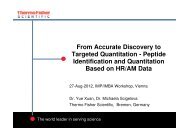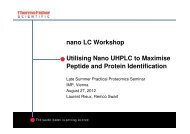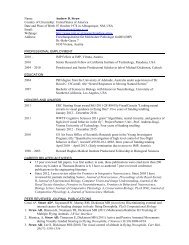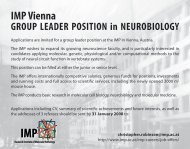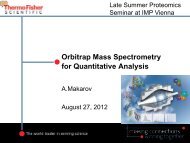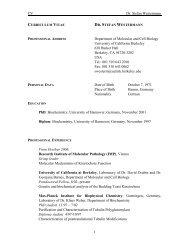IMP Research Report 2002
IMP Research Report 2002
IMP Research Report 2002
You also want an ePaper? Increase the reach of your titles
YUMPU automatically turns print PDFs into web optimized ePapers that Google loves.
Peter STEINLEIN / Staff Scientist<br />
Anton BEYER / Scientist<br />
Sebastian CAROTTA 1 / PhD Student<br />
Volker LEIDL / Software Architect<br />
Karin PAIHA / Microscopy and Imaging<br />
Martin RADOLF / Microarrays<br />
Gabriele STENGL / Flow cytometry<br />
1<br />
joint project with H. Beug<br />
BIOOPTICS DEPARTMENT<br />
The services offered to the researchers at the <strong>IMP</strong> by our department cover flow<br />
cytometry and cell sorting, a wide variety of microscopical techniques, image analysis<br />
and processing as well as cDNA microarray production and analysis.<br />
Flow cytometry<br />
Over the past year we have faced an increasing<br />
demand for rare cell sorting, i.e. the isolation of fewer<br />
than 0.1% target cells in a cell population. Using<br />
automated magnetic cell sorting (AutoMACS), we have<br />
established a simple and highly reproducible procedure<br />
that improves purity and yield of such rare cell sorts.<br />
Microscopy and image analysis<br />
living and fixed samples. To ensure better utilisation of<br />
our equipment and facilities, an Intranet-based<br />
scheduling and booking system has been implemented.<br />
Microarrays<br />
This year, to improve data analysis, we have almost<br />
finished the integration of 13 public databases like<br />
LocusLink, Interpro, CDD, or Gene Ontology into our<br />
The last year witnessed the arrival of a spinning disk<br />
confocal and a Zeiss LSM510 Meta laser scanning<br />
microscopes, both suited for live cell imaging. The<br />
spinning disk confocal is specialised for high-resolution<br />
4D-analysis of living cells expressing GFP. The Zeiss<br />
LSM510 Meta microscope can perform spectral<br />
analysis of multicolour fluorescence, which allows the<br />
separation of fluorescence dyes even with highly<br />
overlapping emission spectra, e.g. GFP and FITCsignals.<br />
Also, technologies like FRET (Fluorescence<br />
Resonance Energy Transfer) with high spatial and<br />
spectral resolution can now be routinely applied to both,<br />
data management system, allowing rapid and<br />
comprehensive access to most of the publicly available<br />
information. Consequently, it is now possible to quickly<br />
assign structural and functional information to clones<br />
identified in microarray experiments. We are also<br />
implementing a more sophisticated system for the<br />
evaluation of microarray data including robust<br />
normalisation within and between experiments and<br />
application of different clustering algorithms.<br />
Contact: steinlein@imp.univie.ac.at<br />
Figure: Cells transfected with YFP were co-stained with Sytox Green and imaged using the Zeiss LSM510 Meta. A spectral analysis was performed<br />
and a colour-coded image is shown in A. Although the emission spectra of the two fluochromes highly overlap, as seen in B, a clear separation of the<br />
Sytox Green (C) and the YFP (D) signal is apparent.<br />
Biooptics department<br />
43




